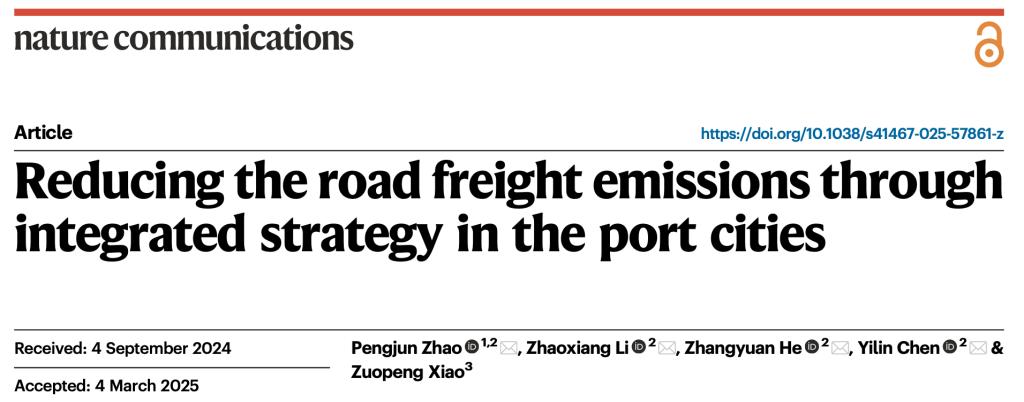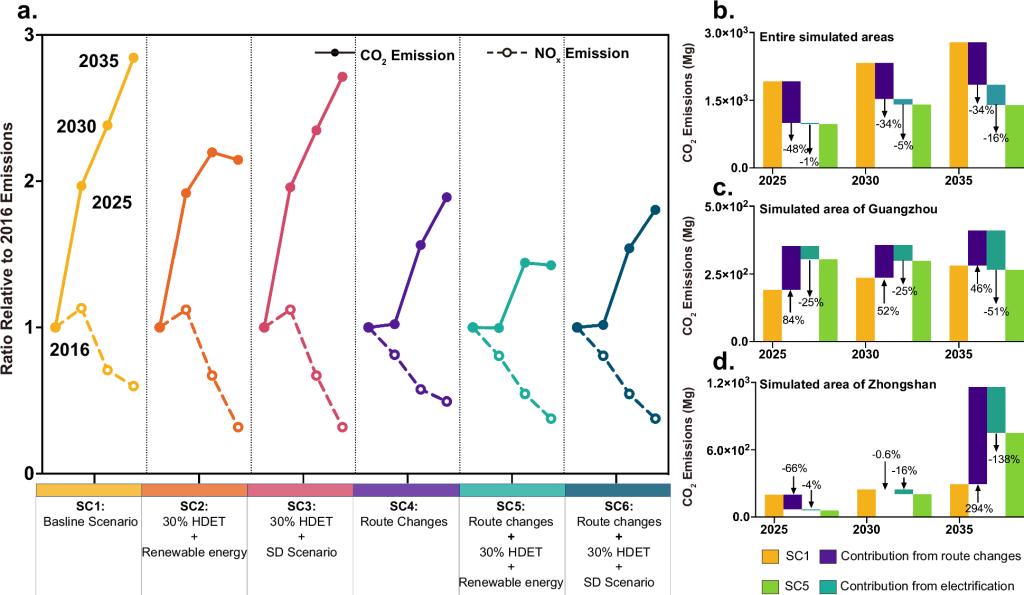
Port cities, which host 50% of the world’s wealth and nearly 40% of the global population within 100 kilometers of coastlines, play a critical role in the global supply chain. However, they are increasingly challenged by carbon emissions and air pollution from transportation. Developing green, low-carbon transport systems in port cities has become a central scientific and policy focus in achieving sustainable urban development.
A research team led by Professor Pengjun Zhao at Peking University has developed a novel Integrated Future Emission Projection Platform (IFEPP). This framework combines trajectory-based microscopic emission modeling, traffic flow simulation, and fleet statistical modeling, while dynamically accounting for changes in freight demand, fleet electrification, and road network evolution.
Using 1.2 billion GPS records of heavy-duty trucks (HDTs) in Shenzhen—the world’s fourth-largest port city—the study evaluated the joint emission reduction effects of fleet electrification and road network development on CO₂ and air pollutants in the Pearl River Delta (PRD) region between 2016 and 2035.
Key Findings
Emission Concentration in Port Cores
The study found that core port areas accounted for 12% and 13% of total CO₂ and NOₓ emissions, respectively. The high volume of HDT traffic in dense urban zones exacerbates both congestion and emissions, particularly where freight corridors overlap residential areas, increasing public exposure to pollutants (Figure 1).

Figure 1. Spatial Distribution of CO₂ Emissions from Heavy-Duty Trucks in the Pearl River Delta Region, Shenzhen, 2016.
Baseline Emissions to 2035
Under the baseline scenario, HDT numbers are projected to rise from approximately 19,000 in 2016 to 66,000 in 2035. Despite increasing adoption of stricter emission standards (e.g., China VI), total CO₂ and CO emissions are expected to grow at an average rate of 5.7% annually due to fleet expansion.
Impact of Electrification under Grid Scenarios
Under a zero-emission power grid scenario, a 30% annual increase in electric HDTs (HDETs) would result in CO₂ peaking by 2033. Under a sustainable development (SD) grid scenario (47% renewable energy), electrification could still yield an 18.5% reduction in CO₂, though emissions would not peak by 2035.
Effect of Road Network Connectivity
Infrastructure development was shown to significantly curb emissions growth. In areas with improved road connectivity, CO₂ emissions increased by only 89%, compared to 184% in the baseline. Enhanced connectivity also reduced NOₓ emissions by 11% and shifted high-emission zones toward less populated southwestern regions (Figure 2).

Figure 2: The performance of improving the connectivity of the regional road network in reducing CO2 and NOx emissions from heavy trucks in the simulated area.
Strategic Insights
The research further explored the synergistic impact of combining fleet electrification with road infrastructure development. Results showed that before 2030, improvements in road connectivity are more effective in curbing emissions than electrification alone, especially as HDET adoption rates remain below 30%.
By integrating both strategies, the model projects a 34% reduction in peak CO₂ emissions and 43% in NOₓ emissions, ensuring near-term reductions while meeting long-term climate goals (Figure 3). These findings offer valuable insights for formulating future sustainable freight policies and emission reduction strategies in port city clusters.

Figure 3: Emission scenarios under different heavy truck emission reduction strategies from 2016 to 2035.
Publication & Acknowledgment
The study, titled "Reducing the road freight emissions through integrated strategy in the port cities", was published online in Nature Communications on March 15, 2025.
Professor Pengjun Zhao is the first and corresponding author. Co-authors include Master’s student Zhaoxiang Li, Dr. Zhangyuan He, and Assistant Professor Yilin Chen. The research was supported by the National Natural Science Foundation of China (Grant No. 41925003).
👉 Read the full article on Nature Communications:https://www.nature.com/articles/s41467-025-57861-z